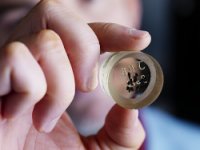Clean Fossil Energy Capabilities
Creating the future of emissions management
Clean Fossil Energy draws upon capabilities in subsurface science and applied materials and process engineering to deliver on its mission of fueling the world with clean hydrocarbon energy.
Subsurface science
Biogeochemical reactions
PNNL's subsurface capability builds upon 30 years of subsurface transport modeling with integrated experimental platforms from micron to field scale. Our subsurface science research provides the foundation for understanding biogeochemical reactions, energy, and mass transfer and is applied to our work with fossil fuel extraction, conversion, and carbon sequestration.
Subsurface science applied to carbon sequestration
We are developing science-based simulation tools to conceptualize and predict the behavior of sequestered carbon dioxide and related contaminants generated by fossil-fuel-burning power plants. These tools build on new capabilities in geomechanics, geophysics, extreme-scale computing, and fundamental interactions in molecular biology.
Our subsurface science approach to sequestration integrates characterization, modeling, and monitoring of geologic systems. Scientific discovery begins with laboratory experiments that reveal the reactions of supercritical carbon dioxide with different types of media in the subsurface. Molecular dynamics simulations are used to verify experimental results. New knowledge is incorporated into simulation codes using Subsurface Transport Over Multiple Phases (STOMP-CO2), a PNNL-developed computer model that more accurately predicts subsurface fate and transport, and scales up fundamental interactions to reservoir scale.
Applying science to advance the application of carbon sequestration
Scientific understanding, simulation and real-world program performance must be integrated to ensure successful application of carbon sequestration. Field projects allow us to rapidly incorporate new data into simulations and verify that the models we are developing reflect real-life settings and reactions. They also help us to identify new scientific challenges in sequestration that need to be addressed for successful application
- Regional Carbon Sequestration Partnerships (RCSPs)—The U.S. Department of Energy has created a network of seven regional partnerships to help develop the technology, infrastructure, and regulations to implement large-scale CO2 sequestration in different regions and geologic formations in our country. Battelle researchers at PNNL play key roles in two DOE partnerships: The Big Sky Carbon Sequestration Partnership (BSCSP) and the Midwest Regional Carbon Sequestration Partnership (MRCSP).
- Wallula project—Laboratory tests by Battelle researchers at PNNL have demonstrated the unique geochemical nature of basalts to quickly react with CO2 and form carbonate minerals, the safest and most permanent form for storage in the subsurface. This project should prove the same processes seen in the laboratory also operate deep underground. The Wallula project is part of the The Big Sky Carbon Sequestration Partnership.

PNNL addresses carbon emissions that contribute to climate change. We are studying basalt formations to determine if they will be a safe and permanent storage site for carbon dioxide. This photo shows small grains of basalt that have been mounted in epoxy.
- NRAP—PNNL leads the groundwater impacts team for the U.S. DOE's National Risk Assessment Program (NRAP). NRAP is comprised of five national laboratories that are collaborating to develop a method for calculating risk associated with large-scale CO2 sequestration projects.
- Future Gen 2.0—FutureGen is a first-of-its-kind, near-zero emissions power plant coupled with an integrated underground CO2 storage reservoir. Battelle, which manages Pacific Northwest National Laboratory, is providing technical and administrative support to the FutureGen Alliance. Specifically, Battelle researchers at PNNL are working to site, design, construct, and operate a CO2 pipeline and storage reservoir that will transport and sequester all the CO2 produced by FutureGen's oxy-combustion large-scale demonstration facility in a deep saline geologic formation. The pipeline and reservoir will be designed to transport and sequester a minimum of 1.3 million metric tons of CO2 per year.
GS3—A collaborative platform
To enable faster design and regulatory acceptance of subsurface reservoirs and monitoring systems, we have developed a unique computer-based knowledge management system. The Geologic Sequestration Software Suite, or GS3, is a web-based platform that will accelerate the translation of subsurface data into scientific understanding and, in turn, prediction and simulation. GS3 will allow new data and scientific understanding to be rapidly validated and incorporated into modeling tools that are accessible to all users.
In Situ Supercritical Suite, or IS3, is a group of one-of-a-kind instruments that will allow researchers to probe geochemical reactions under supercritical pressures and temperatures. Information provided by IS3 feeds directly into GS3 for simulating the performance of a future injection site. Instrumentation at EMSL (a national scientific user facility at PNNL sponsored by the U.S. Department of Energy) has been modified for high pressure and temperature sequestration experiments. These experiments will focus on understanding the supercritical geochemistry of the caprock as well as injection and monitoring boreholes.
Applied materials and process engineering
Novel materials and processes for emissions capture
PNNL is internationally recognized for its capability in applied materials science and process engineering. Our strength is derived from interdisciplinary research that enables
nanostructured and self-assembled materials technology and biomolecular materials for capturing carbon cost-effectively and efficiently. Our research has produced revolutionary materials for carbon capture, including: a reusable organic liquid that can absorb harmful combustion gases such as sulfur dioxide using significantly less energy than current methods; and a reusable catalyst with a unique three-dimensional structure that is highly selective and reactive, with performance that is up to 50 percent better than commercial catalytic materials in laboratory tests.
We use the same interdisciplinary approach to produce tailored thin films, ceramics, and other materials that bring high-performance and cost-effective materials to hostile environments, such as those found in fuel cells.
Emissions Capture Center
The Emissions Capture Development Center brings together PNNL laboratories, equipment, staff expertise and processes to target emissions capture challenges. The Center is designed to develop new technologies that can be scaled up, tested and commercially deployed. Capabilities include molecular-scale modeling for materials discovery, an emissions capture test laboratory, and a structured evaluation process to help rapidly screen and mature technologies. The Emissions Capture Center will be key not only in creating new materials, but in turning them into commercially viable technologies.
